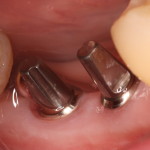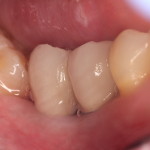Dental Implant Esthetics
There are several factors that contribute to dental implant esthetics. These include position of the dental implants, distance between implants and teeth, and anatomy of remaining bone. Many patients present with deviations from ideal that contribute to difficulties that jeopardize the esthetic outcome. Gingival papillae is the tissue that lies between the dental implants that allows for a natural appearance around dental implant restorations. The two important factors that affect the presence of this tissue includes the distance from the base of inter proximal contact and bone and spacing between the implants. Studies have shown that when the spacing between implants and distance between the contact and bone is less than 3 mm, occurrence of the papillae is diminished. Bone loss can be attributed to previous periodontal disease, trauma, and disuse atrophy.
The current case is a patient with a history of periodontal disease that has remained stable for years. The patient’s periodontal health has remained stable due improved home care and a commitment to recall appointments (cleanings). I explained to the patient that there is increased probability of the dreaded black triangles (lack of papillae) due to the bone loss. The patient was comfortable with this due to the fact that the implants would be located in a posterior area that would not be visible. I surgically placed two straumann dental implants that were restored after osteointegration. It is important for a practitioner to have a clear cut idea about the esthetic outcome of dental implants. If any deviations are anticipated, than these concerns need to be explained with the patient before treatment is rendered.
- Unrestored Dental Implants
- Dental Implants-Porcelain Crowns
If you are interested in how dental implants can change your life,
Check out our Dental Implants Page.





 by
by 


